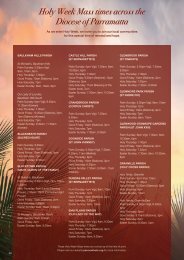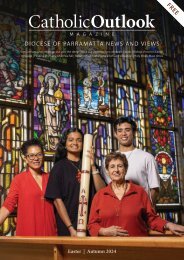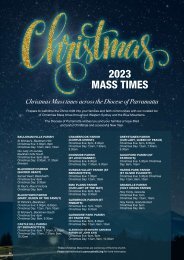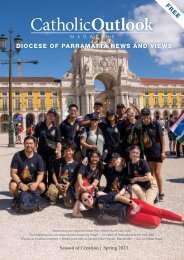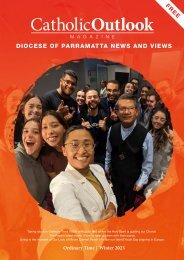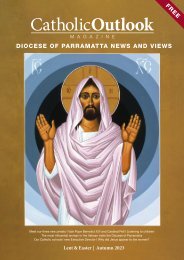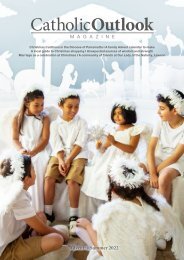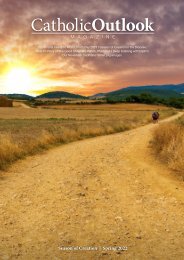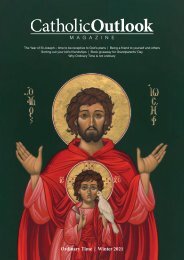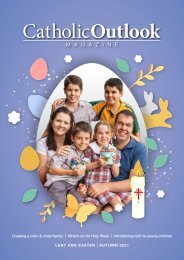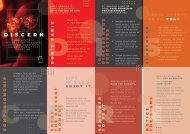You also want an ePaper? Increase the reach of your titles
YUMPU automatically turns print PDFs into web optimized ePapers that Google loves.
GOOD FRIDAY
Solemn Commemoration of the Lord’s Passion
s
10th April, 2020
THE SACRED PASCHAL TRIDUUM
‘
Celebrants
Most Rev. Vincent Long Van Nguyen OFM Conv. DD
Fourth Bishop of Parramatta
Very Rev. Robert Bossini PP,
Parish Priest and Dean of the Cathedral
Deacon
Rev. Mr. Roderick Pirotta
Master of Ceremonies
Rev. Christopher Del Rosario,
Liturgy Ministry
Cathedral Acolytes, Altar Servers, & Readers
Music Ministry
Mr. Bernard Kirkpatrick,
Director of Music
St Patrick’s Cathedral Schola & Cantors
The Easter Triduum begins with the evening Mass of the Lord’s Supper,
reaches its high point in the Easter Vigil,
and closes with Evening Prayer on Easter Sunday.
The celebration of the Triduum
is the culmination of the entire liturgical year.’ (Ordo)
2
GOOD FRIDAY - 10 April, 2020
SOLEMN COMMEMORATION OF THE LORD’S PASSION
Good Friday is the only day of the year when the Eucharist is not celebrated
throughout the world. On this day, commemorating the full and perfect sacrifice
on Calvary, the re-presentation of the sacrifice of the mass is not offered
– so as to better focus on the real and historical event of the death of
Jesus. The Liturgy of the Word and the pre-sanctified communion reminds
us that the fruits of his death and resurrection are available today in the
same way they were made available on that day when his blood poured
forth and cleansed the sin of the world.
The service begins in silence, with the prostration of the Bishop and ministers.
In terms of Catholic gesture; the bow shows respect, the genuflection
greater respect, the double-genuflection even deeper respect, and the prostration
is a sign of total submission to the power and grace of the sacrifice
of Jesus Christ. This sign of absolute submission is otherwise used only
before ordination; and symbolises the willingness to die to this life; and so
to be raised up at the last day.
Please join in singing the hymns, responses and acclamations of the liturgy.
______________________________________________________
Prayer
The Bishop says:
Remember your mercies, O Lord,
and with your eternal protection sanctify your servants,
for whom Christ your Son, by the shedding of his Blood,
established the Paschal Mystery.
Who lives and reigns for ever and ever. ℟ Amen.
3
THE LITURGY OF THE WORD
A Reading from the Prophet Isaiah 52:13— 53:12
He surrendered himself to death, while bearing the faults of many.
See, my servant will prosper,
he shall be lifted up, exalted, rise to great heights.
As the crowds were appalled on seeing him
- so disfigured did he look
that he seemed no longer human -
so will the crowds be astonished at him,
and kings stand speechless before him;
for they shall see something never told
and witness something never heard before:
'Who could believe what we have heard,
and to whom has the power of the Lord been revealed?'
Like a sapling he grew up in front of us,
like a root in arid ground.
Without beauty, without majesty (we saw him),
no looks to attract our eyes;
a thing despised and rejected by men,
a man of sorrows and familiar with suffering,
a man to make people screen their faces;
he was despised and we took no account of him.
And yet ours were the sufferings he bore,
ours the sorrows he carried.
But we, we thought of him as someone punished,
struck by God, and brought low.
Yet he was pierced through for our faults,
crushed for our sins.
On him lies a punishment that brings us peace,
and through his wounds we are healed.
4
We had all gone astray like sheep,
each taking his own way,
and the Lord burdened him
with the sins of all of us.
Harshly dealt with, he bore it humbly,
he never opened his mouth,
like a lamb that is led to the slaughter-house,
like a sheep that is dumb before its shearers,
never opening its mouth.
By force and by law he was taken;
would anyone plead his cause?
Yes, he was torn away from the land of the living,
for our faults struck down in death.
They gave him a grave with the wicked,
a tomb with the rich,
though he had done no wrong
and there had been no perjury in his mouth.
The Lord has been pleased to crush him with suffering.
If he offers his life in atonement,
he shall see his heirs, he shall have a long life
and through him what the Lord wishes will be done.
His soul's anguish over he shall see the light and be content.
By his sufferings shall my servant justify many,
taking their faults on himself.
Hence I will grant whole hordes for his tribute,
he shall divide the spoil with the mighty,
for surrendering himself to death
and letting himself be taken for a sinner,
while he was bearing the faults of many
and praying all the time for sinners.
The word of the Lord. ℟ Thanks be to God.
5
Responsorial Psalm Ps 30:2. 6. 12-13. 15-17. 25
1. In you, O Lord, I take refuge.
Let me never be put to shame.
In your justice, set me free.
Into your hands I commend my spirit.
It is you who will redeem me, Lord. ℟
2. In the face of all my foes
I am a reproach,
an object of scorn to my neighbours
and of fear to my friends. ℟
3. Those who see me in the street
run far away from me.
I am like a dead man, forgotten in men's hearts,
like a thing thrown away. ℟
4. But as for me, I trust in you, Lord,
I say: 'You are my God.'
My life is in your hands, deliver me
from the hands of those who hate me. ℟
5. Let your face shine on your servant.
Save me in your love.
Be strong, let your heart take courage,
all who hope in the Lord. ℟
6
A reading from the Letter to the Hebrews 4:14—16; 5:7—9
He learned obedience and became the source of eternal salvation f
or all who obey him.
Since in Jesus, the Son of God, we have the supreme high priest who
has gone through to the highest heaven, we must never let go of the
faith that we have professed. For it is not as if we had a high priest
who was incapable of feeling our weaknesses with us; but we have
one who has been tempted in every way that we are, though he is without
sin. Let us be confident, then, in approaching the throne of grace,
that we shall have mercy from him and find grace, when we are in
need of help.
During his life on earth, he offered up prayer and entreaty, aloud and
in silent tears, to the one who had the power to save him out of death,
and he submitted so humbly that his prayer was heard. Although he
was a Son, he learnt to obey through suffering, but having been made
perfect, he became for all who obey him the source of eternal salvation.
The word of the Lord.
℟ Thanks be to God.
Gospel Acclamation
Philippians 2:8-9 (JB)
The cantors, alone, intone the acclamation. All repeat.
Christ became obedient for us even to death, dying on the cross.
Therefore God raised him on high
and gave him a name above all other names. ℟
7
The Passion of our Lord Jesus Christ according to John
(18:1 - 19:42)
(The Passion is sung to the traditional Gregorian chant tone.)
The assembly is invited to join in singing the crowd parts with the choir.
Jesus left with his disciples and crossed the Kedron valley. There was
a garden there, and he went into it with his disciples. Judas the
traitor knew the place well, since Jesus had often met his disciples
there, and he brought the cohort to this place together with a detachment
of guards sent by the chief priests and the Pharisees, all with
lanterns and torches and weapons. Knowing everything that was going
to happen to him, Jesus then came forward and said, “Who are
you looking for ?”
C. And they answered,
“Jesus the Nazarene”.
C. He said, “I am he”. C. Now Judas the traitor was standing
among them. When Jesus said, “I am he” , they moved back and
fell to the ground. He asked them a second time, “Who are you
looking for ? ” C. And they said
“Jesus the Nazarene”.
C. Jesus replied “I have told you that I am he. If I am the one
you are looking for, let these others go.” C. This was to fulfil the
words he had spoken, "Not one of those you gave me have I lost.”
Simon Peter, who carried a sword, drew it and wounded the high
priest’s servant, cutting off his right ear. The servant’s name was
Malchus. Jesus said to Peter, “Put your sword back in its scabbard;
am I not to drink the cup that the Father has given me?”
C. The cohort and its captain and the Jewish guards seized Jesus and
bound him. They took him first to Annas, because Annas was the
father-in-law of Caiaphas, who was high priest that year. It was Caiaphas
who had suggested to the Jews, “It is better for one man to die
for the people.”
8
Simon Peter, with another disciple, followed Jesus. This disciple,
who was known to the high priest, went with Jesus into the high
priest’s palace, but Peter stayed outside the door. So the other disciple,
the one known to the high priest, went out, spoke to the woman
who was keeping the door and brought Peter in. The maid on duty
at the door said to Peter, S. “Aren’t you another of that man’s disciples?”
C. And he answered, S. “I am not.” C. Now it was cold,
and the servants and guards had lit a charcoal fire and were standing
there warming themselves; so Peter stood there too, warming himself
with the others.
The high priest questioned Jesus about his disciples and his teaching.
Jesus answered. “I have spoken openly for all the world to hear; I
have always taught in the synagogue and in the Temple where all the
Jews meet together: I have said nothing in secret. But why ask me?
Ask my hearers what I taught: they know what I said.”
C. At these words, one of the guards standing by gave Jesus a slap in
the face, saying, S. “Is that the way to answer the high priest?” C.
Jesus replied, “If there is something wrong in what I said, point it
out; but if there is no offence in it, why do you strike me?” C. Then
Annas sent him, still bound, to Caiaphas, the high priest.
As Simon Peter stood there warming himself, someone said to him,
S. “Aren’t you another of his disciples?” C. He denied it saying,
S. “I am not.” C. One of the high priest’s servants, a relation of
the man whose ear Peter had cut off, said, S. “Didn’t I see you in
the garden with him?” C. Again Peter denied it; and at once a cock
crew.
They then led Jesus from the house of Caiaphas to the Praetorium. It
was now morning. They did not go into the Praetorium themselves
or they would be defiled and unable to eat the Passover. So Pilate
came outside to them and said, S. “What charge do you bring against
this man?” C. they replied,
“If he were not a criminal, we should not be handing him
o-ver to you.”
9
C. Pilate said, S. “Take him yourselves, and try him by your own
Law. “ C. The Jews answered,
“We are not allowed to put a man to death.
C. this was to fulfil the words Jesus had spoken indicating the way he
was going to die. So Pilate went back into the Praetorium and called
Jesus to him, and asked: S. “Are you the king of the Jews?” C. Jesus
replied, “Do you ask this of your own accord, or have others spoken
to you about me?” C. Pilate answered, S. “ Am I a Jew? It is your
own people and the chief priests who have handed you over to me:
what have you done?” C. Jesus replied, “Mine is not a kingdom of
this world; if my kingdom were of this world, my men would have
fought to prevent my being surrendered to the Jews. But my kingdom
is not of this kind.” C. Pilate said, S. “So you are a king then?” C.
Jesus answered It is you who say it. Yes, I am a king. I was born
for this, I came into the world for this; to bear witness to the truth;
and all who are on the side of truth listen to my voice.” C. Pilate said
S. “Truth? What is that?” C . And with that he went out again to the
Jews and said, S. “I find no case against him. But according to a custom
of yours I should release one prisoner at the Passover; would you
like me, then, to release the king of the Jews?”
C. at this they shouted:
“Not this man, but Ba-rab-bas”
C. Barabbas was a brigand. Pilate then had Jesus taken away and
scourged; and after this, the soldiers twisted some thorns into a crown
and put it on his head, and dressed him in a purple robe. They kept
coming up to him and saying,
“Hail, king of the Jews!”
10
C. and they slapped him in the face. Pilate came outside again and
said to them, S.” Look, I am going to bring him out to you to let you
see that I find no case. “ C. Jesus then came out wearing the crown of
thorns and the purple robe. Pilate said, S. “Here is the man.” C.
When they saw him the chief priests and the guards shouted,
Cru-ci-fy him! Cru-ci-fy him.
C. Pilate said, “Take him yourselves and crucify him: I can find no
case against him.”
C. The Jews replied:
“We have a Law, and according to the Law he ought to die,
because he has claimed to be the Son of God.”
C. When Pilate heard them say this his fears increased. Re-entering
the Praetorium, he said to Jesus S. “Where do you come from?” C.
But Jesus made no answer. Pilate then said to him, S. “Are you refusing
to speak to me? Surely you know I have power to release you and
I have power to crucify you?” c. Jesus replied You would have no
power over me if it had not been given you from above; that is why
the one who handed me over to you has the greater guilt.” C. From
that moment Pilate was anxious to set him free, but the Jews shouted
“ If you set him free you are no friend of Caesar’s;
anyone who makes himself king is de-fying Caesar.
11
C. Hearing these words, Pilate had Jesus brought out, and seated on the
chair of judgement at a place called the Pavement, in Hebrew Gabbatha.
It was Passover preparation Day, about the sixth hour Pilate
said to the Jews, S. “Here is your king.”
C. They said
“Take him away, take him a -way!” “Cru-ci-fy him!”
C. Pilate said, S. “Do you want me to crucify your king?” C. The
chief priests answered,
“We have no king ex-cept Cae-sar.”
C. So in the end Pilate handed him over to them to be crucified.
Then they took charge of Jesus, and carrying his own cross he went
out of the city to the place of the skull or, as it was called in Hebrew,
Golgotha, where they crucified him with two others, one on either side
with Jesus in the middle. Pilate wrote out a notice and had it fixed to
the cross; it ran: “Jesus the Nazarene, King of the Jews.” This notice
was read by many of the Jews, because the place where Jesus was crucified
was not far from the city, and the writing was in Hebrew, Latin
and Greek. So the Jewish chief priests said to Pilate,
“You should not write “King of the Jews but “This man said:
I am King of the Jews”.
C. Pilate answered, S. “What I have written, I have written.”
C. When the soldiers had finished crucifying Jesus they took his clothing
and divided it into four shares, one for each soldier. His undergarment
was seamless, woven in one piece from neck to hem; so they
said to one another, S.” Instead of tearing it, let’s throw dice to decide
who is to have it. “
12
C. In this way the words of scripture were fulfilled: they shared out
my clothing among them, they cast lots for my clothes. This is exactly
what the soldiers did. Near the cross of Jesus stood his mother and
his mother’s sister, Mary the wife of Clopas, and Mary of Magdala.
Seeing his mother and the disciple he loved standing near her, Jesus
said to his mother, “Woman, this is your son.” C. Then to the disciple
he said, “This is your mother.” C. And from that moment the disciple
made a place for her in his home. After this Jesus knew that everything
had now been completed, and to fulfil the scripture perfectly he
said: I am thirsty.” C. A jar full of vinegar stood there, so putting
a sponge soaked in the vinegar on a hyssop stick they held it up to his
mouth. After Jesus had taken the vinegar he said,
“It is accomplished”; C. and bowing his head he gave up the spirit.
[ALL KNEEL]
It was Preparation Day, and to prevent the bodies remaining on the
cross during the Sabbath – since that Sabbath was a day of special
solemnity – the Jews asked Pilate to have the legs broken and the bodies
taken away. …Consequently the soldiers came and broke the legs
of the first man who had been crucified with him and then of the other.
When they came to Jesus, they found that he was already dead, and so
instead of breaking his legs one of the soldiers pierced his side with a
lance; and immediately there came out blood and water. This is the
evidence of one who saw it – trustworthy evidence, and he knows he
speaks the truth – and he gives it so that you may believe as well. Because
all this happened to fulfil the words of scripture: Not one bone
of his will be broken, and again, in another place scripture says: they
will look on the one whom they have pierced.
After this, Joseph of Arimathaea, who was a disciple of Jesus, though
a secret one because he was afraid of the Jews – asked Pilate to let him
remove the body of Jesus. Pilate gave permission, so they came and
took it away. Nicodemus came as well – the same one who had first
come to Jesus at night-time – and he brought a mixture of myrrh and
aloes, weighing about a hundred pounds. They took the body of Jesus
and wrapped it with the spices in linen cloths, following the Jewish
burial custom.
At the place where he had been crucified there was a garden, and in
the garden a new tomb in which no one had yet been buried. Since it
was the Jewish Day of Preparation and the tomb was near at hand ,
they laid Jesus there.
13
Homily
Most Rev. Vincent Long Van Nguyen OFM Conv
Bishop of Parramatta
Universal Prayer
After each intention is announced there is a brief pause when all may pray silently; the
prayer is then sung. The intentions are selected from the following traditional sequence
of the Universal Prayer.
I. FOR HOLY CHURCH
II.
III.
IV.
FOR THE POPE
FOR ALL ORDERS AND DEGREES OF THE FAITHFUL
FOR CATECHUMENS
V. FOR THE UNITY OF CHRISTIANS
VI. FOR THE JEWISH PEOPLE
VII. FOR THOSE WHO DO NOT BELIEVE IN CHRIST
VIII. FOR THOSE WHO DO NOT BELIEVE IN GOD
IX. FOR THOSE IN PUBLIC OFFICE
X. FOR THOSE IN TRIBULATION
At the end of each prayer,
All join in the response:
VENERATION OF THE CROSS
All stand as the Cross is unveiled. As the Cross is uncovered, the following Responsory
is sung three times:
Behold the wood of the Cross, on which hung the salvation of the world:
All respond:
After the cross has been shown, the bishop approaches and reverences the cross.
During the veneration of the cross the choir sings the “Reproaches”.
14
The Reproaches Popule meus T.L de Victoria
Popule Meus quid fecit tibi?
Aut in quo contristavi te?
Responde mihi.
Agios o Theos Sanctus Deus
Agios ischyros Sanctus fortis
Agios athanatos eleison imas
Sanctus et immortalis miserere nobis
My people what have I done to you?
How have I offended you?
Answer me!
Holy is God!
Holy and Strong!
Holy immortal one,
Have mercy on us!
Antiphon Jesus, remember me Taizé
15
THE COMMUNION RITE
The altar is prepared with a cloth. The reserved sacrament is brought from the place of reposition
to the altar in preparation for Holy Communion.
The Lord’s Prayer
At the Saviour’s command and formed by divine teaching, we dare to say:
Deliver us, Lord, we pray, from every evil, graciously grant peace in our
days, that, by the help of your mercy, we may be always free from sin and
safe from all distress, as we await the blessed hope and the coming of our
Saviour, Jesus Christ.
16
During communion the choir sings
Caligaverunt oculi mei
T. L. de Victoria
Caligaverunt oculi mei a fletu meo :
quia elongatus est a me, qui consolabatur me.
Videte omnes populi.
*Si est dolor similis sicut dolor meus.
V. O vos omnes qui transitis per viam,
attendite et videte.
R. Si est dolor similis sicut dolor meus.
My eyes are darkened by my tears:
For He is far from me that comforted me:
See, all you people,
if there be sorrow like my sorrow.
V. O all you who pass by,
behold and see
R. if there be sorrow like my sorrow.
Prayer after Communion
Let us pray;
Almighty ever-living God,
who have restored us to life
by the blessed Death and Resurrection of your Christ,
preserve in us the work of your mercy,
that, by partaking of this mystery,
we may have a life unceasingly devoted to you.
Through Christ our Lord.
℟ Amen.
17
Hymn
The Lord is now exalted
18




